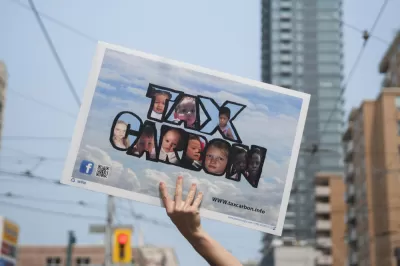New research suggests that cutting greenhouse gas emissions from the transportation sector would have tremendous benefits to public health.

The Transportation, Equity, Climate and Health (TRECH) project at the Center for Climate, Health, and the Global Environment of the Harvard T.H. Chan School of Public Health is a multi-university research initiative tasked with conducting an independent analysis of policy scenarios under consideration by the Transportation Climate Initiative (TCI) to address carbon pollution from the transportation sector.
The TCI is a collaboration between multiple Northeastern and Mid-Atlantic states to cut emissions from the transportation sector (Planetizen has been tracking the genesis of the TCI since 2018). To help decide a memorandum for TCI, "the TRECH Project team has estimated health outcomes for five illustrative TCI policy scenarios representing a range of emissions reduction caps and investment strategies," according to the TRECH website.
Here's a quick sample the key findings from TRECH's research, with a lot more detail, and a few more findings, provided in the source article.
- The estimated health benefits under the five TCI climate mitigation policy scenarios are substantial and are larger than estimated TCI program proceeds, for a subset of benefits examined.
- The TCI policy scenario with the largest estimated health benefits has the most ambitious emissions reduction cap and the largest share of investments dedicated to public transit and active mobility.
- Under all five policy scenarios, health benefits are estimated to occur in all counties across the region and are concentrated in more populated areas.
The article also explains and illustrates the five policy scenarios under examination.
FULL STORY: New TRECH Project Research Update on Health Benefits of TCI Policy Scenarios

Planetizen Federal Action Tracker
A weekly monitor of how Trump’s orders and actions are impacting planners and planning in America.

Maui's Vacation Rental Debate Turns Ugly
Verbal attacks, misinformation campaigns and fistfights plague a high-stakes debate to convert thousands of vacation rentals into long-term housing.

San Francisco Suspends Traffic Calming Amidst Record Deaths
Citing “a challenging fiscal landscape,” the city will cease the program on the heels of 42 traffic deaths, including 24 pedestrians.

Amtrak Rolls Out New Orleans to Alabama “Mardi Gras” Train
The new service will operate morning and evening departures between Mobile and New Orleans.

The Subversive Car-Free Guide to Trump's Great American Road Trip
Car-free ways to access Chicagoland’s best tourist attractions.

San Antonio and Austin are Fusing Into one Massive Megaregion
The region spanning the two central Texas cities is growing fast, posing challenges for local infrastructure and water supplies.
Urban Design for Planners 1: Software Tools
This six-course series explores essential urban design concepts using open source software and equips planners with the tools they need to participate fully in the urban design process.
Planning for Universal Design
Learn the tools for implementing Universal Design in planning regulations.
Heyer Gruel & Associates PA
JM Goldson LLC
Custer County Colorado
City of Camden Redevelopment Agency
City of Astoria
Transportation Research & Education Center (TREC) at Portland State University
Jefferson Parish Government
Camden Redevelopment Agency
City of Claremont





























